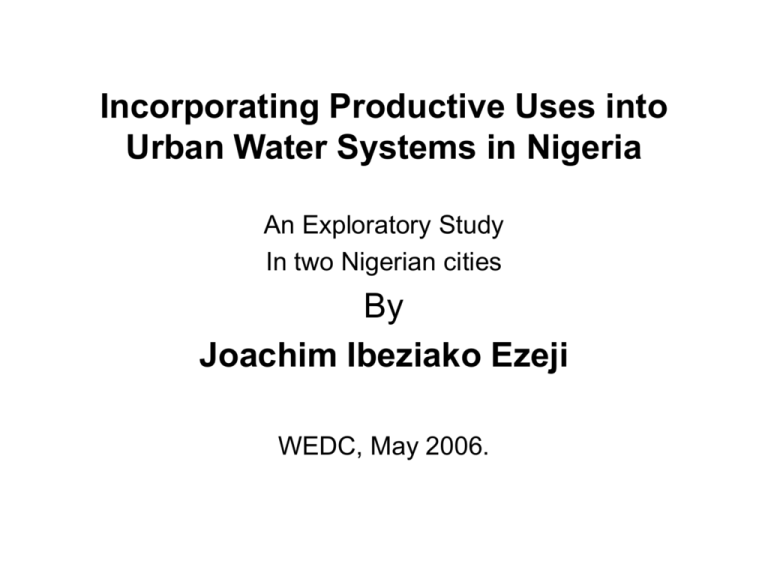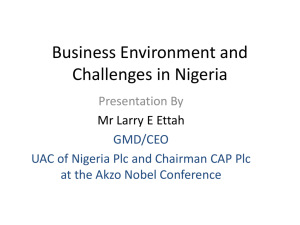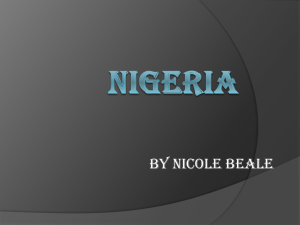Ezeji - Multiple Use water Services Group
advertisement

Incorporating Productive Uses into Urban Water Systems in Nigeria An Exploratory Study In two Nigerian cities By Joachim Ibeziako Ezeji WEDC, May 2006. Aim of Study: • To assess the possibility of incorporating productive uses into urban water system designs in Nigeria. • To assist to inform the design of reforms in the Nigerian water sector. • To assist governments and donors grapple with the problems of poverty in Nigeria, because an understanding of how the poor respond to economic crisis has become increasingly important. This understanding can help ensure that interventions aimed at reducing poverty complement and strengthen people’s own inventive solutions rather than block them. ( Moser, 1996:1). The Objectives: • 1) To explore how households can benefit from water dependent productive activities. • 2) To assess efficiency and equity in water supply and use, through appropriate demand management and conservation strategies. • 3) To identify appropriate and affordable water catchments and delivery technologies germane for productive use. • 4) To assess existing supply interventions and establish links with gender and poverty. Country Profile • • • • • Population:130.2million (UN,2005) Capital: Abuja Administrative Structure:36 states Area:923,768sq.km Urban Population:50%(at a growth rate of 5.5% per annum) • Poverty level: Between 54.4% and 70% Country Profile (contd) Water Resources Endowment • • • • • • • Surface Water : 268 billion m3 Groundwater:52 billion m3 Major rivers: 24 Large lake:1 Natural Springs: Several Rainfall: about 180-225cm (in the South) And 100-150cm in the North. Urban Nigeria in brief Case Study:1 Living on water. • At least, 65 workers of Nigeria's premier cement factory, the Nigerian Cement Company Plc (NIGERCEM), Nkalagu, have died of stress and starvation since production stopped in 2000. • According to, Mr. Festus Eze, a security guard with the moribund cement company, “ the last time salaries were paid to workers was in 2001, and they had been living on charity since then”. • "Unfortunately, the workers had been dying one after another since then, " he said. • "We are really distressed. I fetch and sell water to feed my family. A jerry can of water sells for N25 and I had to fetch at least 10 jerry cans to be able to feed my family everyday." • - SOURCE: The Guardian, March 20, 2006. • • • • • • • Case Study:2 Water Scarcity hits Dutse Dutse, the capital city of Jigawa State recently witnessed acute water shortage. The situation became more pathetic when open wells and hand pumps that were dug as alternative sources dried up. People resorted to stagnant water pools from the recent rainfall for domestic uses. Prices charged by hawkers of the ‘clean water’ went up, such that a 5litres can of water increased to N30 from N10, while an ablution kettle water went from N1 to N5,yet scarce. According to the state water board "Out of our three stand by generators in Shuwari water station, the supplier to Dutse city two have broken down while the only one remaining lacks adequate supply of fuel from the headquarter." SOURCE: The Independent, May 2, 2006. Case Study:3 State Water Utilities indicted • The United Nations Children's Fund (UNICEF) and World Health Organization (WHO) recently conducted an urban water assessment in Nigeria. • The report urged the government to establish national regulatory agency for sanitation and water supply schemes in the country. • Reason: because of the poor performance of many public water agencies in the supply of potable water to the people. • Source: Adeze Ojukwu, Daily Champion, May 5, 2006. Case Study:4 Even a pastor ! • The judicial panel of inquiry investigating failed contracts in Benue State has ordered a Pentecostal pastor, Rev. John Orgunze to appear before it over complicity in a N50 million water contract for markudi city. • Orgunze was alleged to have failed to execute a N50 million water project after collecting a 50 percent mobilization fee. • SOURCE: The Independent, May 8,2006. Case Study:5 Illegal Connections. • Recently, the Investigation and Monitoring Unit of Kano State Water Board, commenced massive disconnection of illegal water pipelines, connected by commercial stand pipe operators, commercial bath houses, car wash operators and producers of sachet water popularly known as ‘pure water’. • Between, 11th May to 1st June, 2006, a total number of 40 illegal pipes were disconnected. • The disconnection exercise affected 18 Bath houses, 15 commercial stand pipes, 2 car wash points and 2 pure water factories. • Contd. Case Study:5 Illegal Connections (contd.) • Though the state Water Board gave licenses to owners of the commercial stand pipe operators, and Bath houses, they made multiple connections and constructed over head and underground tanks for storing water, contrary to operational regulations. • These illegalities prevented other domestic consumers from getting water, as the vendors through their actions diverted it for their commercial purposes. • Besides construction of storage tanks, the operators of the unlawful act also boosted the speed of the water thereby hijacking it from other consumers. • Source: Mustapha Isah Kwaru , Daily Trust, June 2,2006 A Conceptual Framework and socioeconomic characteristics of the two cities: Jos, Plateau State. Current Status of Water Utility. • State-owned agency • Unable to generate sufficient funds from consumers – Limits the provision of sustainable water supply in parts of Jos • PSWB presently has a total of 4 schemes in the city – Combined design capacity of 101mld – 15,700 connections • Treated water from the PSWB – Good water quality – Serves approximately 728,000 people • Water availability is irregular – Shortfall of a million people • Their water is from private boreholes, water vendors or local streams Conceptual framework and socioeconomic characteristics of the two cities.( Owerri, Imo State) Men Women Most of the women are full time housewives Average distance covered in collecting water in Jos. < 0.5km 0.5-1.0 km Wet Season Dry Season Males Males Females Females 1.1- 2.0 km > 2.0 km . Conceptual framework and socioeconomic characteristics (contd.) • Besides domestic uses, water forms the focus of the following widespread economic activities in these cities; • -Beer brewing otherwise known as ‘mmaya nkwu’, ‘kunu’ and ‘burukutu’ etc;mini abattoir, pure water, ice block, household gardening, bath-shops, household poultry, animal husbandry, roof tile, bricks, tea shops, restaurants, cold drinks, car washing, laundry etc. Conceptual Framework and socioeconomic characteristics (contd.) • a) What is being analyzed? • -Contributions of household water supplies to household income; quite beyond the benefits of drinking, cooking, bathing and laundry water. • -And to an extent a review of the PRSP of Nigeria to understand the focus of poverty strategies as it affects enhanced government expenditure programmes on water and sanitation; and institutional reforms to improve water governance or pro-poor investments etc. Conceptual Framework (contd.): • b) What is the welfare measure being assessed? • -This study focuses on assessing water distribution impacts on welfare or well being, including its income dimensions. The study will explore appropriate indicators of welfare and poverty based on the country Nigeria and policy context. Conceptual Framework (contd.) : • c) Whose welfare is being analyzed? • -This study is also interested on the distributional impacts of reforms or policy change in the water sector, on various groups, with a particular focus on the poor and those vulnerable to impoverishment. Groups in this study may be defined in terms of income class, gender, age, geographical location, livelihood, or other such criteria. Posers to be resolved: • To what extent does asset e.g. house or land ownership infringe on these productive enterprises ?. • How much water is needed and how much is enough ?. • How supplies the water? • Can we quantify its impact to poverty reduction? Posers to be resolved (contd.) • • • • • • • How do we commence incorporation? The ratio of men and women involved? Does quality of water matter? Are their potential threats? What level of tariff is being paid? How much income is being generated? Are socioeconomic needs really met? Etc. Methods of data collection • 1) Secondary sources e.g. official documents such as government publications, Donor reports, NGO bulletins, earlier research, newspapers and personal records etc. • 2) Primary sources e.g. Interviews and use of questionnaires. Research Methodology and Process • • • • • • • • • • • • • • >Formulation of research problem. >Conceptualization of research design. >Literature review -Development of a theoretical framework. -Development of a conceptual framework. >Selection of a sample strategy -Quota Surveys. >Development of data collection instruments -Questionnaires -Interviews. >Research Proposal. >Data Collection. >Processing data. >Research Report. Output • Study Report • Workshops • Thanks……







